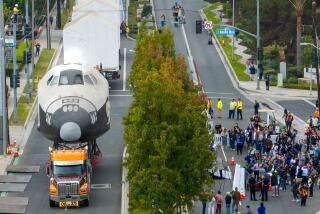Charting space shuttle history on the Southland map
Look hard and the ghosts of the nation’s 40-year-old space shuttle program can be found hidden in plain sight across Southern California.
They inhabit a sprawling, virtually lifeless building in Canoga Park, where an army of Rocketdyne aerospace engineers once forged shuttle engines amid a haze of cigarette smoke and the clatter of mechanical calculators.
They can be found in the Mojave Desert, at a secured Air Force base in Palmdale, where the shuttles were assembled in a hangar now being used by Boeing Co. to temporarily store office furniture.
PHOTOS: Endeavour’s final flight
And — for the moment at least — they can be found in Downey, where long-armed excavators tear through the 120-acre Boeing facility where many of the shuttle’s parts were manufactured. A complex that once employed 12,000 people is now a mountain of rubble, its history unknown to passersby.
As the space shuttle Endeavour is readied for its final, 12-mile voyage through Inglewood and Los Angeles to the California Science Center this week, it is a bittersweet reminder of the economic, technological and social impact the program had on Southern California.
The space shuttle helped carry the region’s aerospace industry for four decades, providing jobs to engineers from Ivy League universities, blue-collar technicians fresh out of high school and scores of mom-and-pop shops that supplied thousands of parts.
“The space shuttle program is what made aerospace the economic underpinning for the middle class in Southern California for most of the post-World War II period,” said Peter Westwick, author of “Blue Sky Metropolis: The Aerospace Century in Southern California. “At its peak, the shuttle program employed some 20,000 people across the Southland. Entire careers were spent building and maintaining the fleet.
For many, it was more than just a good-paying job. Unique engineering challenges required true invention. There was a sense of purpose in helping to send astronauts into space and a profound feeling of responsibility for their lives.
“When I arrived here 35 years ago, we were still using slide rules.... It was just a bustle of activity here,” said Jim Paulsen, 65, vice president and program manager for space launch systems at Rocketdyne in Canoga Park. “Every time it flew, it was an extremely emotional experience for me.”
When Columbia blasted off on its maiden journey 31 years ago, a worker at a small subcontractor in Hawthorne summed up the feeling of thousands: “It couldn’t have flown without me.”
“People throw around words like passion and pride,” said Al Hoffman, a top manager for Boeing who oversaw the assembly and maintenance of the orbiters in Palmdale. “But if you really wanted to see it, you needed to come to work on the shuttle program,” which he said was the premier job in the aerospace industry.
“It’s a space ship, and it does a lot of great things,” he said. “A B-2 bomber does only one thing — when it’s allowed to. The shuttle was used as everything from a science lab to a UPS truck,” ferrying supplies to the space station and deploying satellites.
Like many shuttle engineers, Hoffman believes the fleet was retired before its time, the victim of tight budgets and shifting public attitudes.
“After a while (a shuttle launch) became routine to the public,” he said. “It just wasn’t as sexy as the newest technology, things like the latest video games and telephones.”
While Endeavour’s retirement to Los Angeles marks the end of NASA’s shuttle program, its footprint in California began to shrink even before that last orbiter was completed in May 1991.
After North American Rockwell in Downey won the shuttle contract in 1972, workers packed the bar at the Tahitian Village motel across the street to drink and celebrate. The tiki-themed “renowned luxury motor court” embodied the ring-a-ding-ding boom times powered by billions of dollars of space work. Astronauts and celebrities were drawn to its lush tropical grounds and entertained by fire dancers.
By the 1990s the Tahitian Village was rundown and uninviting — a symbol of the region’s retrenching aerospace industry.
One recent day Paulsen walked through the quiet corridors of the 500,000-square-foot Rocketdyne plant where the space shuttle engines were built. “To see it idle like this is very emotional,” he said.
The plant eventually will be torn down. But until then, the place is a museum of ancient technology.
“This is the controller,” Paulsen said, pointing to one hulking electronic welder that looks like a prop from a 1960s sci-fi movie. “Your smartphone has more capability than this does.”
It’s all government surplus that will either be sold or scrapped.
Some pieces are so specialized — or so massive — that it’s unlikely anyone would pay to move them.
Need a medieval looking three-story tall furnace used to bake shuttle engine nozzles?
“You can have it if you’d like,” Paulsen said.
Down in Huntington Beach, on the nearly empty fifth floor of an office building on Boeing’s sprawling campus, nine engineers peck away at computers in cubicles they’ve adorned with framed photos of the shuttle the way parents display portraits of their children.
These are the last shuttle workers in California. Once Endeavour is delivered to the Science Center their job will be done.
Bill Roberts, 56, is a Boeing engineer who began working on the shuttle program straight out of college in 1982. Now he plans for Endeavour’s final trip to the Science Center.
“When they made a decision to retire the shuttles, it was difficult,” he said. “But that was a decision that we had no control over. In this business you can’t get too emotional about the end of programs.”
Indeed, in this quiet office of empty desks there’s a sign that counsels: “Don’t cry because it is over. Smile because it happened.”
More to Read
Sign up for Essential California
The most important California stories and recommendations in your inbox every morning.
You may occasionally receive promotional content from the Los Angeles Times.











